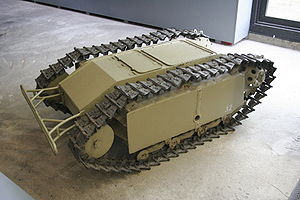
Back Goliath Catalan Goliath (lehký nosič nálože) Czech Goliath (Panzer) German Goliath (vehículo teledirigido) Spanish Goliath roomikmiin Estonian مین شنیدار گولیات Persian Goliath (tela-ajoneuvo) Finnish Goliath (chenillé) French גוליית (רכב) HE Goliath (kendaraan penghancur) ID
This article has multiple issues. Please help improve it or discuss these issues on the talk page. (Learn how and when to remove these template messages)
|
| Goliath Sd.kfz 302 | |
|---|---|
 A SdKfz. 302, displayed at the Deutsches Panzermuseum, Munster (2005) | |
| Type | Demolition vehicle |
| Place of origin | Nazi Germany |
| Service history | |
| In service | 1942–1945 |
| Used by | Nazi Germany Romania |
| Wars | World War II |
| Production history | |
| Designed | 1942 |
| Manufacturer | Borgward and Zündapp |
| Unit cost | 3,000 ℛℳ (1942) (€12,577 in 2021) |
| Produced | 1942–1944 |
| No. built | 7,564 |
| Specifications | |
| Mass | 370 kg (820 lb) |
| Length | 1.5 m (4.9 ft) |
| Width | 0.85 m (2.8 ft) |
| Height | 0.56 m (1.8 ft) |
| Crew | One remote operator |
| Armor | 5 mm (0.20 in) |
Main armament | 60 kg (130 lb) explosive charge |
| Engine | Two Electric Motors 2 x 2.5 hp (1.9 kW) |
| Ground clearance | 11.4 cm (4.5 in) |
Operational range | 1.5 km (0.93 mi) on-road; 0.75 km (0.47 mi) off-road. |
| Maximum speed | 6 km/h (3.7 mph) |
| References | |
The Goliath tracked mine (German: Leichter Ladungsträger Goliath, "Goliath Light Charge Carrier") was a series of two unmanned ground vehicles used by the German Army as disposable demolition vehicles during World War II. These were the electrically powered Sd.Kfz. 302 and the petrol-engine powered Sd.Kfz. 303a and 303b. They were known as "beetle tanks" by the Allies.[1]
They carried 60 or 100 kg (130 or 220 lb) of high explosives, depending on the model, and were intended to be used for multiple purposes, such as destroying tanks, disrupting dense infantry formations, and the demolition of buildings or bridges. Goliaths were single-use vehicles that were destroyed by the detonation of their warhead.
© MMXXIII Rich X Search. We shall prevail. All rights reserved. Rich X Search